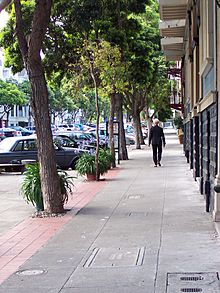Duboce Triangle, San Francisco facts for kids
Quick facts for kids
Duboce Triangle
|
|
|---|---|

Sanchez Street near 14th Street
|
|
| Country | |
| State | |
| City and county | San Francisco |
| Area | |
| • Total | 0.114 sq mi (0.30 km2) |
| Population
(2020)
|
|
| • Total | 3,425 |
| • Density | 30,092/sq mi (11,619/km2) |
| Time zone | UTC-8 (Pacific) |
| • Summer (DST) | UTC-7 (PDT) |
| Area codes | 415/628 |
The Duboce Triangle is a cool neighborhood in San Francisco, California. It sits below Buena Vista Park. You can find it between the neighborhoods of the Castro, the Mission District, and the Lower Haight.
This area gets less fog than many other parts of San Francisco. This is because it is located east of Buena Vista Heights and Twin Peaks. Public transport like Muni Metro trains and buses serve the neighborhood.
Contents
Where is Duboce Triangle?
The Duboce Triangle is a small but important part of San Francisco. It has clear borders that help define it.
Neighborhood Boundaries
The neighborhood is bordered by several main streets. Market Street forms its southeastern edge. Castro Street is on its western side. Duboce Avenue marks its northern boundary.
Duboce Park Inclusion
Some definitions of the neighborhood include Duboce Park. This park is a popular spot for locals. It adds to the green spaces in the area.
History of Duboce Triangle
The name Duboce Triangle comes from an interesting person. It is named after Victor Duboce. He was a lieutenant colonel in the military. He served in the Philippines during the Spanish–American War.
Old Buildings and Homes
Many homes in Duboce Triangle are quite old. Some were built in the 1870s. For example, a house at 22 Beaver Street was built in 1876. Many buildings are "1906 flats" in the classic revival style. This means they were built or rebuilt after the big 1906 earthquake.
Surviving the Earthquake
One special building is a Victorian apartment building. It is located on the north side of 400 Duboce Avenue. This building survived the 1906 earthquake. It is known as one of the largest wooden structures west of the Mississippi River.

